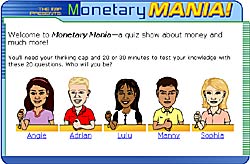|
Monetary Mania
Summary
 This site provides students with a quiz show format for reviewing economics concepts.
This site provides students with a quiz show format for reviewing economics concepts.
Audience
14-18 year olds (9-12 graders, US) studying Social Studies and Economics in school.
Lesson Applications
Before students log on to the Monetary Mania quiz program, they should have learned the
associated vocabulary. The important terms are listed below and should be introduced in a variety of Social Studies, Language Arts or Business classes; or in a
discussion of current events.
Money
Anything that people will routinely accept in exchange for goods and services
Dollar
The Spanish-milled dollar, known also as "pieces of eight," was widely used in colonial America. This dollar coin was made of one ounce of silver, and minted
in the Spanish colonies of Mexico and Peru.
European Union
European economic and political integration that began in the 1950s; born in the hope that shared sovereignty would make another war in Europe unthinkable.
Hard currency
Currency whose value is certain and trusted by other countries.
Interest rates
The cost of borrowing money.
Exchange rates
The cost of one currency relative to another in the world market.
GDP
Gross Domestic Product is the total market value of all final goods and services produced in a country in a year.
Protectionism
The restriction on imports of goods and services from other countries.
Balance of payments
A record of a country's transactions with the rest of the world: payments for goods and services and their borrowing, lending and investment.
Gold standard
A monetary policy in which the value of a currency is tied to a specific amount of gold.
Beggar thy neighbor
Adopting economic policies that try to gain a benefit by hurting other countries, e.g., tariffs, quotas, embargoes.
Benefits of globalization
- Exporters can get good prices for their goods
- Products not produced in your own country are available
- People are communicating in many languages.
IMF's birthplace
Bretton Woods, New Hampshire.
Key function of the IMF
Stable monetary relations.
Main activities of the IMF
- Assessment of economic, monetary, fiscal, and exchange.
- Loans to member countries with balance of payments problems.
- Technical assistance in the management of their fiscal problems.
Monetary Mania
EconEd Online |